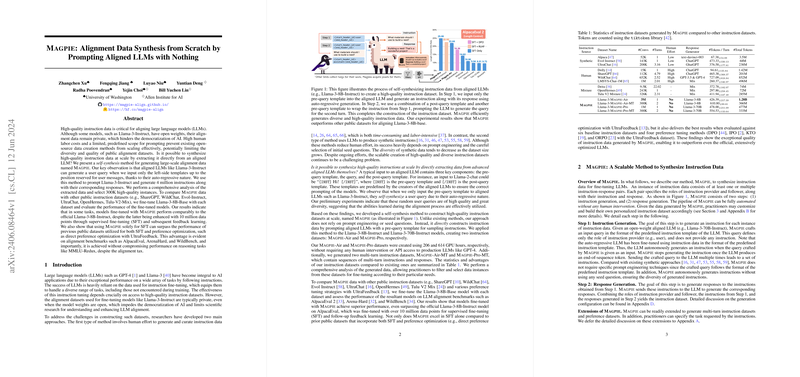Overview of "Magpie: Alignment Data Synthesis from Scratch by Prompting Aligned LLMs with Nothing"
Introduction
The paper "Magpie: Alignment Data Synthesis from Scratch by Prompting Aligned LLMs with Nothing" addresses the challenge of generating high-quality instruction data essential for aligning LLMs. The motivation behind this work arises from the often private nature of alignment datasets associated with models like Llama-3-Instruct, which impede broader access and hinder the advancement and scrutiny of LLM alignment methods. Traditional methods of creating these datasets either involve labor-intensive human curation or rely on intricate prompt engineering, limiting their scalability and diversity.
Methodology
The primary contribution of the paper is the introduction of "Magpie," a self-synthesis method for generating large-scale alignment data. This method leverages the auto-regressive nature of aligned LLMs such as Llama-3-Instruct to generate user queries using predefined templates. Notably, Magpie does not require elaborate prompt engineering or initial seed questions, distinguishing it from existing synthetic approaches.
The methodology consists of two main steps:
- Instruction Generation: By providing only a pre-query template to the LLM, Magpie elicits the auto-regressive generation of high-quality, diverse instructions.
- Response Generation: These instructions are fed back into the LLM to produce corresponding responses, thus completing the instruction dataset.
Magpie efficiently generates both single-turn and multi-turn datasets (Magpie-Air, Magpie-Air-MT, Magpie-Pro, Magpie-Pro-MT), requiring modest computational resources without human intervention.
Evaluation and Results
The evaluation encompasses both quantitative and qualitative metrics, comparing Magpie-generated datasets with prominent public datasets like ShareGPT, WildChat, Evol-Instruct, UltraChat, OpenHermes, and Tulu-V2-Mix. The performance comparison involves fine-tuning Llama-3-8B-Base with each dataset and assessing the resulting models on alignment benchmarks such as AlpacaEval, Arena-Hard, and WildBench.
Key findings indicate:
- Models fine-tuned with Magpie data perform comparably to the official Llama-3-8B-Instruct model, which is fine-tuned with substantially more data points (over 10 million).
- Magpie data surpasses previous public datasets, even when used solely for supervised fine-tuning (SFT), affirming the quality and utility of Magpie-generated instructions.
- The advantage of Magpie is particularly noticeable in alignment benchmarks, demonstrating robust performance without compromising on reasoning tasks or incurring significant alignment tax.
Implications and Future Directions
The implications of this research are multifaceted:
- Practical Implications: Magpie offers a scalable, cost-efficient solution for generating alignment data, effectively democratizing the development and refinement of LLMs. The reduced dependency on human labor and advanced prompting techniques enables broader participation and innovation in AI alignment research.
- Theoretical Implications: The success of Magpie underscores the potential of leveraging prealigned LLMs for self-synthesis, paving the way for future exploration into automated data generation techniques. This could lead to deeper insights into model behaviors and their alignment capabilities.
Future research directions could include:
- Domain-Specific Data Generation: Expanding Magpie to cater to specific domains such as mathematics or programming by refining the system prompt or incorporating domain-specific constraints.
- Hybrid Approaches: Integrating Magpie with other data generation or augmentation methods to further enhance the diversity and coverage of instruction datasets.
- Advanced Evaluation Metrics: Developing more granular and comprehensive evaluation benchmarks that can capture the nuanced improvements brought about by different alignment datasets.
Conclusion
Overall, the Magpie methodology represents a significant advancement in the domain of LLM alignment data generation. By addressing the limitations of existing methods, Magpie not only enhances the performance of fine-tuned models but also fosters a more inclusive and accessible approach to AI alignment research. The promising results and scalability of Magpie open new avenues for both practical applications and theoretical investigations in the field of artificial intelligence.
